Chicago Police Department
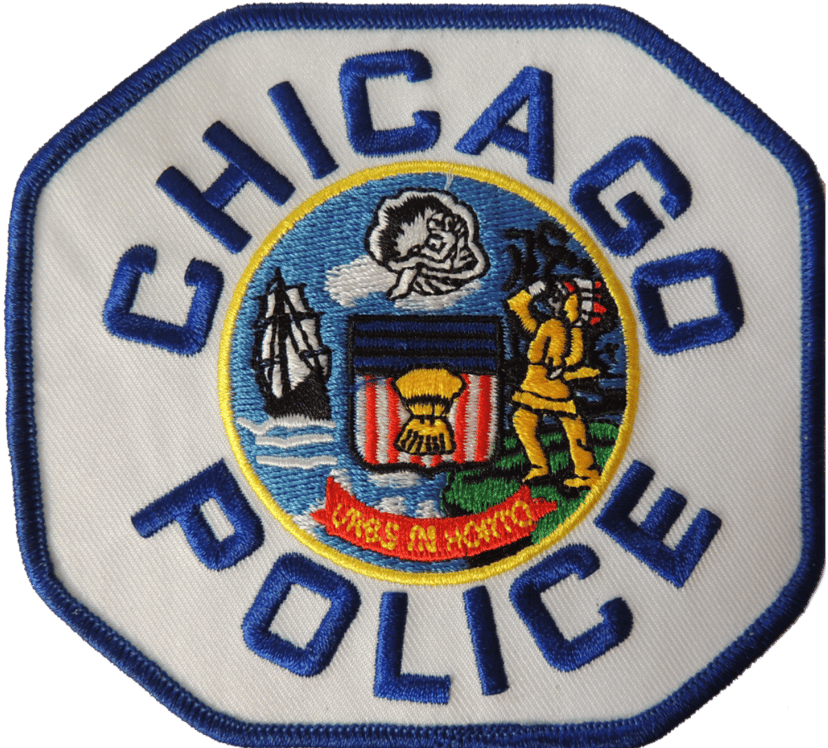
Chicago Police Department

| Chicago Police Department | |
|---|---|
 Seal | |
 Badge | |
| Common name | Chicago P.D. |
| Abbreviation | CPD |
| Motto | We Serve and Protect |
| Agency overview | |
| Formed | 1835 (183 years ago) |
| Employees | 13,500 (2018)[1] |
| Annual budget | $1,6 billion (2018 est.) |
| Jurisdictional structure | |
| Operations jurisdiction | Chicago, Illinois, U.S. |
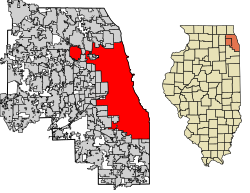 | |
| Jurisdictional area | |
| Size | 237 sq mi (610 km2) |
| Population | 2,720,546 (2016) |
| Legal jurisdiction | As per operations jurisdiction |
| Governing body | Chicago City Council |
| General nature |
|
| Headquarters | 3510 S. Michigan Ave Chicago, Illinois, U.S. |
| Officers | 11,944 (2012)[1] |
| Unsworn members | 822 (2012)[1] |
| Mayor of Chicago responsible |
|
| Agency executives |
|
| Bureaus | 6
|
| Facilities | |
| Districts | 22 [2]
|
| Website | |
| www.chicagopolice.org [92] | |
The Chicago Police Department (CPD) is the law enforcement agency of the U.S. city of Chicago, Illinois, under the jurisdiction of the City Council. It is the second-largest municipal police department in the United States, behind the New York City Police Department.[3] It has approximately 13,500 officers and over 1,925 other employees.[4] Tracing its roots back to the year of 1835,[5] the Chicago Police Department is one of the oldest modern police forces in the world.
In recent years, the United States Department of Justice has criticized the department for its poor training, lack of oversight and routine use of excessive force.[6]
| Chicago Police Department | |
|---|---|
 Seal | |
 Badge | |
| Common name | Chicago P.D. |
| Abbreviation | CPD |
| Motto | We Serve and Protect |
| Agency overview | |
| Formed | 1835 (183 years ago) |
| Employees | 13,500 (2018)[1] |
| Annual budget | $1,6 billion (2018 est.) |
| Jurisdictional structure | |
| Operations jurisdiction | Chicago, Illinois, U.S. |
 | |
| Jurisdictional area | |
| Size | 237 sq mi (610 km2) |
| Population | 2,720,546 (2016) |
| Legal jurisdiction | As per operations jurisdiction |
| Governing body | Chicago City Council |
| General nature |
|
| Headquarters | 3510 S. Michigan Ave Chicago, Illinois, U.S. |
| Officers | 11,944 (2012)[1] |
| Unsworn members | 822 (2012)[1] |
| Mayor of Chicago responsible |
|
| Agency executives |
|
| Bureaus | 6
|
| Facilities | |
| Districts | 22 [2]
|
| Website | |
| www.chicagopolice.org [92] | |
Structure

Chicago police officer
The Superintendent of Police leads the Chicago Police Department. With the assistance of the First Deputy Superintendent, the Superintendent manages four bureaus, each commanded by a bureau chief.
The mayor appointed former Bureau of Patrol Chief Eddie T. Johnson as Superintendent on March 28, 2016. He was preceded by Garry F. McCarthy, former director of the Newark, New Jersey, Police Department, as superintendent; this was approved by the city council on June 8, 2011.[7] McCarthy was the highest paid city employee with an annual salary of $260,004.[8] McCarthy resigned at the request of Mayor Emanuel on December 1, 2015 over the city's high murder rate and his department's handling of the shooting of Laquan McDonald.
Prior to McCarthy's appointment, Jody P. Weis had served as superintendent of police since February 2008. At the time, Weis was the second Chicago police superintendent hired from outside of the city. He replaced Philip J. Cline, who officially retired on August 3, 2007. Weis' contract expired on March 1, 2011. Mayor Richard M. Daley appointed Cline's predecessor, Terry Hillard, on an interim basis.
The current First Deputy Superintendent is Anthony Riccio,[9]) appointed by Mayor Rahm Emanuel.
As of August 2019, the six bureaus of the department and their respective chiefs are:
Bureau of Patrol (BOP): Chief Fred Waller
Bureau of Detectives: Chief Melissa A. Staples
Bureau of Organized Crime (BOC): Chief Salvador Avila
Bureau of Organizational Development: Chief Barbara West
Bureau of Technical Services: Chief Jonathan H. Lewin
Bureau of Internal Affairs: Chief Dana Alexander
Each of these bureau chiefs, with the exception of the Bureau Chief of Internal Affairs, report directly to the First Deputy Superintendent of Police.[9]) The Bureau of Internal Affairs falls under the Office of the Superintendent.
There are 22 police districts, consolidated from 25 in 2012, each led by a commander who oversees his or her district. Commanders report to the three area deputy chiefs, who report to the Bureau of Patrol Chief.
In 1960, the municipal government created a five-member police board charged with nominating a superintendent to be the chief authority over police officers, drafting and adopting rules and regulations governing the police system, submitting budget requests to the city council, and hearing and deciding disciplinary cases involving police officers.[10] Criminologist O.W. Wilson was brought on as Superintendent of Police, and served until 1967 when he retired.[11]
Bureau of Detectives
Investigative functions are under the Bureau of Detectives. The Bureau of Detectives is Headed by the Chief of Detectives. The Detective Division includes the three Area Detective Divisions. The Deputy Chief of the Special Investigations Unit oversees the Central Investigations Division, the Forensic Services Division which includes the Mobile Crime Lab of Forensic Investigators, ET-North and ET-South—which are the two Evidence Technician Units, and the Youth Investigations Division.
The Counter terrorism and Intelligence Division includes the Deployment Operations Center Section, the Intelligence Section, the Airport Law Enforcement Section, the Public Transportation Section, and the Bomb and Arson Section. The Organized Crime Division includes the Narcotics Section, Gang Investigations Section, Gang Enforcement Section, Vice Control Section, and the Asset Forfeiture Unit.
The Chief of Detectives heads the Detective Division; the Chief of Organized Crime heads that division—both reporting to the First Deputy Superintendent. Two Deputy Chiefs assist the Chief of Detectives while one Deputy Chief assists the Chief of OCD.
The city is covered by three Detective Division Areas (North, Central, and South), each led by a Commander.
Bureau of Patrol
The Bureau of Patrol includes the twenty-two districts. Also included in the Bureau of Patrol are the Special Functions Group, the Marine & Helicopter Unit, Mounted Unit, SWAT, the Traffic Section, and the Canine Unit.
Following the disbanding of the Special Operations Section in 2007 after much negative publicity and controversies, the Special Functions Group was formed to absorb the specialized units that were not associated with the controversial plain-clothes unit known informally as SOS. A full-time SWAT team, organized in 2005, includes 70 members. The Motor Unit, based at O'Hare International Airport, is the only unit that uses two-wheeled motorcycles. It includes 28 members as of 2018. They participate in dignitary escorts, parades, and processions for fallen officers. The Mounted Unit maintains 32 gelded horses at the South Shore Cultural Center.[12] The marine unit maintains nine boats; these bear an angled rendering of the Chicago City Flag at the bow, patterned after the United States Coast Guard "racing stripe".
Ranks
| Title | Insignia | Notes |
|---|---|---|
| Superintendent of Police | Appointed by the Mayor of Chicago. Highest rank in the Chicago Police Department. | |
| First Deputy Superintendent of Police | Appointed by the Superintendent of Police. Second Highest rank in the Chicago Police Department. | |
| Chief | Rank since September 8, 2011. Chiefs are typically in charge of a Bureau. | |
| Deputy chief | Rank since September 8, 2011. | |
| Commander | Commanders are typically in charge of a district. | |
| Captain | Captains are typically Executive Officers of Districts. | |
| Lieutenant | ||
| Sergeant | ||
| Field training officer | Field training officers wear one chevron over one rocker, with "FTO" in the center of the insignia, but are not considered ranking officers. | |
| Police officer/assigned as: detective/youth officer/gang specialist/police agent/major accident investigator/ | Chicago detectives are not considered ranking officers, but rather officers assigned to specialized units, e.g. violent crimes, robbery, gang and narcotics (NAGIS), Internal Affairs Division (IAD), Major Accident Investigation Section (MAIS), etc. (Unless they hold the rank of sergeant or above.) | |
| Police officer | Police officers are the first ranking officers. They are dispatched radio assignments, conduct patrol, and respond to other emergencies as needed. |
Insignia
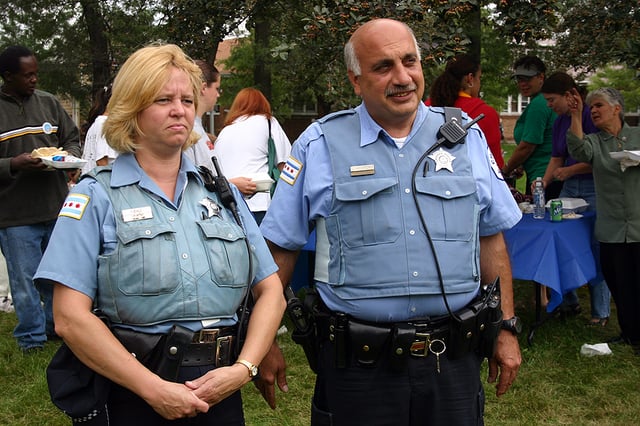
Chicago Police Department officers in Marquette Park
Chicago's five-pointed star-shaped badge (referred to as a "star" instead of a "badge" in the vernacular of the department) also changes to reflect the different ranks of officers. The stars of most Chicago Police officers (patrol officers through to captain) are of silver-colored metal, with broad points. Command ranks have gold-colored stars with sharp points. A ring surrounding the full-color city seal in the star's center changes color for each rank within these two classifications. Like most American police forces, the officer's rank is written in an arc above the center element.
The Chicago Police Department's shoulder sleeve insignia, worn on the top of the left sleeve, is unusual in two regards.
Its shape is octagonal instead of one of the more typical shapes used by most other American police forces.
The embroidery colors vary depending upon the wearer's rank. In all cases, the patch is a white octagon with a full-color rendering of the city seal, ringed in gold, with "Chicago" written in an arc above the seal, and "Police" written in an arc below the seal. For patrol officers and detectives (detectives are occasionally uniformed for ceremonies and details), the octagon's outer edge is finished in dark blue thread, and the text is embroidered in dark blue thread. For sergeants, lieutenants and captains, the octagon's outer edge is finished in gold-colored thread, and the text is embroidered in dark blue thread. For "command ranks" (commander through superintendent), the octagon's outer edge is finished in gold-colored thread, and the text is embroidered in gold-colored thread.
Service longevity is reflected just above the left cuff on most outer garments. Five years of service are indicated by a horizontal bar, embroidered in gold-colored thread; ten years by two bars; fifteen by three bars; twenty by a five-pointed star, embroidered in gold colored thread; twenty-five by one star and one bar and so-forth.
An embroidered rendering of the flag of Chicago, its borders finished in gold-colored thread, is worn on the right shoulder sleeve.
A two-part nameplate in gold-colored metal is worn above the right pocket. The upper portion bears the officer's name; the lower portion indicates the district or command to which the officer is assigned.
The Chicago Police Department is one of only a handful of police agencies in the United States to use the checkered bands on its headgear, known as the Sillitoe Tartan after its originator, Percy Sillitoe, Chief Constable of Glasgow, Scotland in the 1930s. Where British, Australian and New Zealand Sillitoe tartans feature three rows of smaller squares, Chicago's has two rows of larger squares. The checkerboard colors for patrol officers, detectives, dogs and horses are blue and white; the colors for sergeants and higher ranks are blue and gold. Service caps, the campaign hats of the mounted unit, bicycle helmets, knit caps, dog collars, and horse browbands all bear the Sillitoe tartan; the edge of the ball caps' bills show a narrow, flattened Silitoe tartan. The department also uses the pattern on some signage, graphics, and architectural detail on newer police stations.
Salary
Starting salary for Chicago police officers in 2016 is $48,078 increased to $72,510 after 18 months. Promotions to specialized or command positions also increases an officer's base pay. Salaries were supplemented with a $2,920 annual duty availability and an $1,800 annual uniform allowance.[13]
Demographics
50% non-Hispanic White
25% Hispanic (of any race)
21% African American
3% Asian American/Pacific Islander
1% other
Chicago Alternative Policing Strategy (C.A.P.S.)

Chicago Police Department Ford Interceptor Utility
The Chicago Police Department is often credited for advancing community policing through the Chicago Alternative Policing Strategy program. It was established in 1992 and implemented in 1993 by then-Chicago Police Superintendent Matt L. Rodriguez. CAPS is an ongoing effort to bring communities, police, and other city agencies together to prevent crimes rather than react to crimes after they happen. The program entails increasing police presence in individual communities with a force of neighborhood-based beat officers. Beat Community Meetings are held regularly for community members and police officials to discuss potential problems and strategies.
Under CAPS, 9-10 beat officers[15] are assigned to each of Chicago's 279 police beats. The officers patrol the same beat for over a year, allowing them to get to know community members, residents, and business owners and to become familiar with community attitudes and trends. The system also allows for those same community members to get to know their respective officers and learn to be comfortable in approaching them for help when needed. Beat officers are fully equipped and patrol their neighborhoods in a variety of methods: by bike, by car, by ATV, by Segway, or by foot.
Strategic Subject List (SSL)
Strategic Subject List (SSL) is an implementation of a computer algorithm developed by the Illinois Institute of Technology. SSL calculates the propensity of individuals committing or being targeted by gun violence. The fourth iteration now in use, has become a helpful indicator of murders, according to Eddie Johnson, Superintendent of Police.[16]
The system looks at an individual's past criminal activities and specifically excludes biasing variables like race, gender, ethnicity and location according to Illinois Institute of Technology professor Miles Wernick. The algorithm assigns scores to individuals based on criminal records as well as any known gang affiliations and other variables.[17]
As of 2016, the CPD created a list 1,400 of "strategic subjects" that has proven to be accurate and helpful to the department. In 2016, over 70 percent of the people shot have been on the list, and 80 percent of the shooters. According to the CPD, 117 of the 140 people arrested during a citywide gang raid performed in 2016 were on the list. The list is used by social workers and community leaders.[18]
Weapons and duty equipment
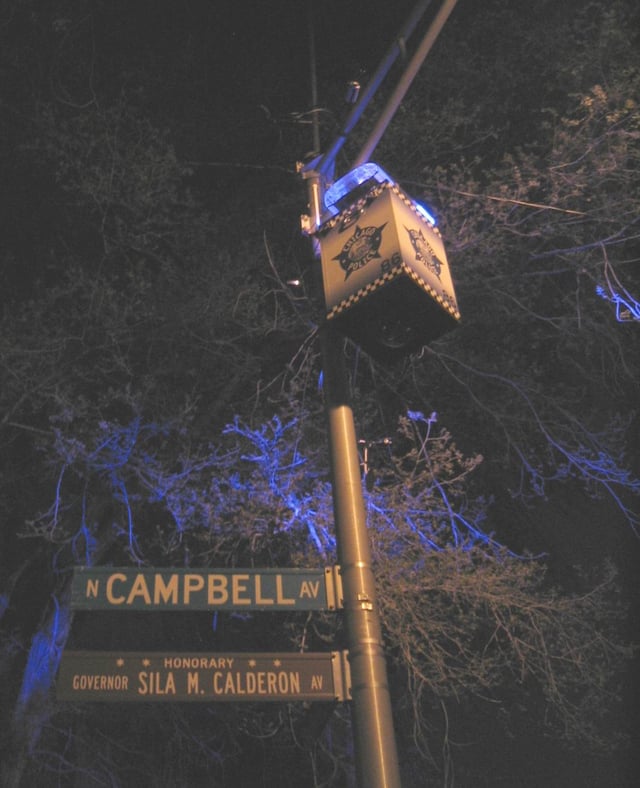
Chicago Police camera in 2006
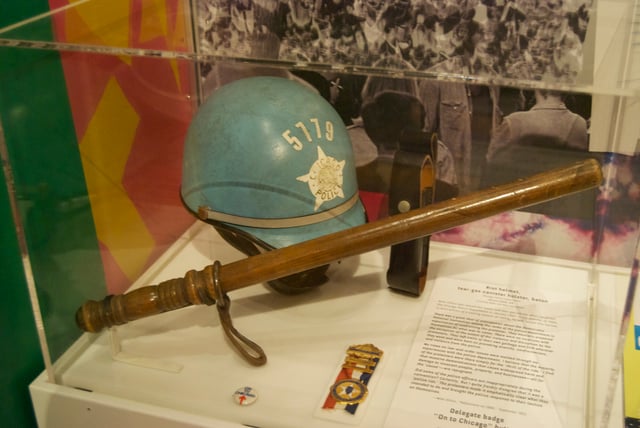
Chicago Police helmet & billy-club circa 1968
Chicago police officers are required to buy their own duty equipment (except Taser x3, x26 and Motorola radio Motorola phone). All field officers must also be qualified to carry a Taser. Some officers choose to carry a backup weapon as well, which must meet certain specifications and requires annual qualification.
The prescribed semiautomatic pistol must meet the following requirements:
Officers who were hired on or before 1 December 1991 may keep their older double-action/single-action pistols, as well as their 4" barrel Smith & Wesson, Ruger or Colt revolvers in .38 Special or .357 Magnum. Recruits hired on or after 28 August 2015 must choose from Springfield Armory, Smith & Wesson, or Glock striker-fired 9mm pistols. Officers hired before 19 May 2008 may continue to use the Double Action Only (DAO) Beretta, Ruger, SIG Sauer, and S&W pistols for duty use.[19]
It was reported in June 2018 that the agency would allow the authorization of the SIG Sauer P320 as another service pistol to be chosen by officers to carry. Shortly after the P320 appeared on the authorized firearms list.[20]
Patrol vehicles contain long gun racks. Remington 870 12-gauge shotguns are available in the event that additional firepower is needed. Officers must complete five days of training to carry an AR-15 type rifle and have the option to purchase their own or use a department provided one.
History
19th century
1820s–1830s

Chicago Police Chief Francis O'Neill 1901–1905
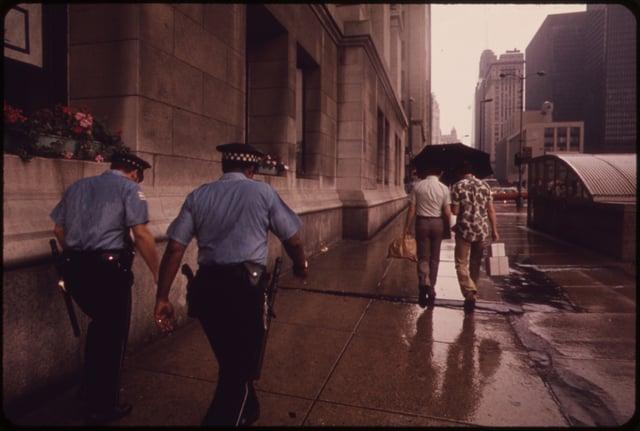
Chicago Police in the rain in 1973 on Michigan Avenue
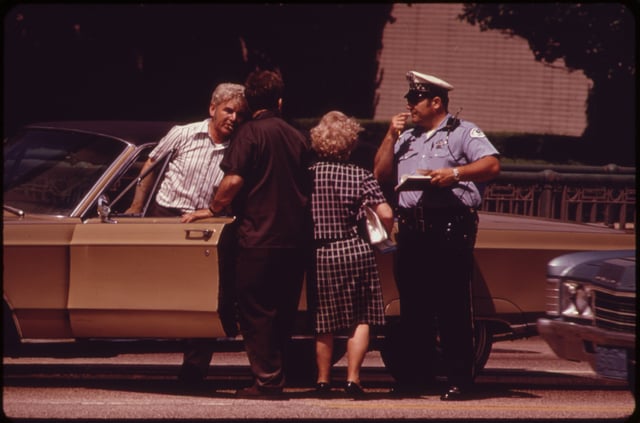
Chicago Police officer in 1973 inquiring about a traffic accident
In 1825, prior to the creation of Cook County, in what would later become, the village of Chicago, was in Putnam County.[21] Archibald Clybourn was appointed to be Constable of the area between the DuPage River and Lake Michigan. Clybourn went on to become an important citizen of the city, and the diagonal Clybourn Avenue is named after him.[22] When the town of Chicago was incorporated to become a city in 1837, provisions were made to elect an officer called the High Constable. He in turn would appoint a Common Constable from each of the six city wards.
1840s–1850s
In 1855, the newly elected city council passed ordinances to formally establish the Chicago Police Department. Chicago was divided into three police precincts, each served by a station house. Station No. 1 was located in a building on State Street between Lake and Randolph streets. Station No. 2 was on West Randolph Street near Des Plaines Street. Station No. 3 was on Michigan Street (since then renamed Hubbard Street[23]) near Clark Street. Political connections were important to joining the force; formal requirements were few, until 1895. After 1856, the department hired many foreign-born recruits, especially unskilled, but English-speaking, Irish immigrants.
1860s–1870s
In 1860, the detective forces were established to investigate and solve crimes. In 1861, the Illinois General Assembly passed a law creating a police board to become an executive department of Chicago autonomous of the mayor. The mayor was effectively stripped of his power to control the Chicago Police Department. Authority was given to three police commissioners. The commissioners created the office of superintendent to be the chief of police. The title is again in use today.
The first African American officer was appointed in 1872, but black police were assigned to duty in plain clothes only, mainly in largely black neighborhoods. In 1875, the Illinois General Assembly found that the police commissioners were unable to control rampant corruption within the Chicago Police Department. The legislature passed a new law returning power over the police to the mayor. The mayor was allowed to appoint a single police commissioner with the advice and consent of the city council.
1880s–1890s
In 1896, a parade of Chicago police officers were the subject of the first film ever to be shot in Chicago.[24]
Women entered the force in 1885, as matrons, caring for female prisoners. Marie Owens is believed to have been the first female police officer in the U.S., joining the Chicago Police Department in 1891, retiring in 1923. Holding the rank of Sergeant, Owens enforced child labor and welfare laws.[25]
Despite centralized policies and practices, the captains who ran the precincts or districts were relatively independent of headquarters, owing their jobs to neighborhood politicians. Decentralization meant that police could respond to local concerns, but graft often determined which concerns got most attention. In 1895, Chicago adopted civil service procedures, and written tests became the basis for hiring and promotion. Standards for recruits rose, though policing remained political.[26]
20th century
1900s–1910s
In 1906, the Department's Mounted Patrol was created to provide crowd control, and in 1908, the force was granted its first three motor cars, expanding in 1910 to motorbikes and boats.[27] Female officers were formally appointed beginning on August 13, 1913, starting with ten officers. In 1918, Grace Wilson, possibly the first black female police officer in United States history, joined the force.
In 1917, the Chicago Police Reserves were formed, organised on a regimental basis. They were used to assist or replace regular officers in high-crowd events, such as Memorial Day, and during the 1918 flu pandemic, worked for two weeks to enforce stringent health regulations.
1920s-1930s
In 1920, the Chicago Police Reserves were disbanded, owing to the failure of the City Council to provide for their organisation.
The Saint Valentine's Day Massacre led to the creation of the United States' first crime laboratory at Northwestern University, purchased by the Department in 1938.
1940s-1950s
The Department's Mounted Patrol was disbanded in 1948.
1960s-1970s
Orlando W. Wilson, the first civilian superintendent, was appointed by the mayor in 1960. A former dean of criminology, Wilson introduced major reforms to the Department, including a new and innovative communications center, the reduction of police stations, a fairer promotion process, and an emphasis on motorized patrol over foot patrol. Vehicles were painted blue and white and given blue lightbars, introducing the familiar silitoe tartan headbands, and the official motto, 'We Serve And Protect'. In 1963, the Cadet Program was also introduced.
The 1968 Democratic National Convention in Grant Park led to major criticism of the Chicago Police's crowd control methods, with the Walker Report criticizing both the Department and the National Guard for use of excessive force, and called the events a police riot.
The Department's Mounted Patrol, due to popular demand, was re-established in 1974, renamed imply as the Mounted Unit.
1980s-1990s
In August 1983, the Chicago Police Department's first African American superintendent, Fred Rice, was appointed by Chicago's first African American mayor, Harold Washington, followed by the first Hispanic superintendent, Matt L. Rodriguez, appointed by Mayor Richard M. Daley in 1992.
In 1994, the Chicago Alternative Policing Strategy (CAPS) was introduced, serving as a model for community policing operations nationwide, and in 1995, the Emergency Management and Communications Center, also known as '9-1-1 Center', opened, combining call-taking operations for all the emergency services across Chicago.
21st Century
2000s-2010s
The new Chicago Police Department Headquarters was opened on June 3, 2000, replacing an extremely aged and outdated building located at 1121 South State Street.
2010s-2020s
New superintendent Eddie Johnson was sworn in on April 13, 2016, upon the resignation of Garry McCarthy.
Fallen officers
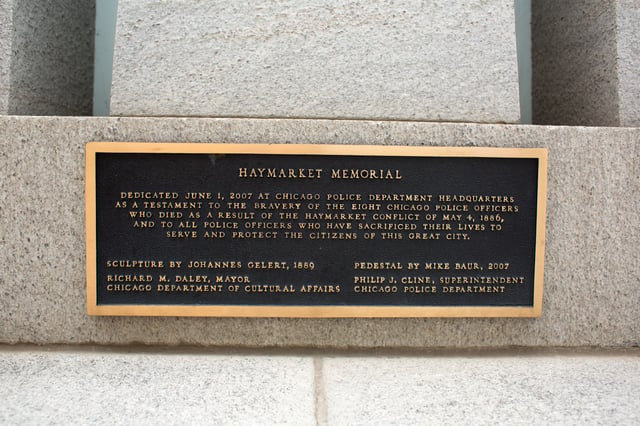
Marker under the Haymarket monument at Chicago Police headquarters
Since 1853, the Chicago Police Department has lost 545 officers in the line of duty.[28] By custom, the department retires the stars of fallen officers and mounts them in a display case at Police Headquarters.
Union
The Chicago Police Department became unionized at the end of 1980.[29] This action was controversial as city officials resisted the union for as long as they could. Chicago police officers are represented by the Fraternal Order of Police.
Appearances in popular culture
The 1957–1960 television series M Squad centered on a squad of Chicago Police detectives. The episode "The Jumper" featured an officer taking bribes. It was reportedly this depiction that prompted then-Mayor Richard J. Daley to thereafter discourage motion picture and television location filming in the city for the rest of his administration and its aftermath. John Landis' successful 1980 musical comedy motion picture The Blues Brothers (see more below) marked the reversal of that policy by Mayor Jane Byrne.
Two notable exceptions to Daley's ban were made for films released in 1975. In Brannigan, John Wayne portrays Chicago Police Lieutenant Jim Brannigan. Cooley High (set in 1964) was filmed entirely in Chicago and features a car chase through Navy Pier's warehouse buildings (since demolished), in which the pursuing Chicago police are repeatedly outmaneuvered by the joyriding teens.
The Chicago Police Department and Illinois State Police are featured in the climactic car chase in 1980's The Blues Brothers in which a Chicago Police dispatcher matter-of-factly advises responding officers that "The use of unnecessary violence in the apprehension of the Blues Brothers has been approved." Reportedly in response to their portrayal in The Blues Brothers, the Chicago Police Department banned the use of the "Chicago Police" name and insignia in films until the early 2000s, resulting in several films and television shows replacing "Chicago Police" with "Metro Police" and other faux names, even if the films received technical assistance from the department, such as The Fugitive and The Negotiator.
The television series Hill Street Blues (1981–1987) never explicitly stated the name of the city in which it was set, although many exterior views (lacking the principal actors) were filmed in Chicago and used for establishing and transition shots. See the main article for expanded discussion on the setting.
Robert De Niro portrays a former Chicago police officer turned bounty hunter in the 1988 film Midnight Run. Numerous references are made to the CPD as well as corruption within the department. There are also a number of scenes directly involving the CPD.
The Chicago Police Department played a major role in 1993's The Fugitive, showing them in a semi-brutal fashion after Kimble is incorrectly believed to have killed an on-duty police officer. The use of actual Chicago Police Department vehicles and uniforms is extensive and can be seen throughout the film.
In the 1998 film The Negotiator, the Chicago Police played a major role within the film. The real Chicago Police Department provided technical support for the movie's SWAT teams. The actors' shoulder sleeve insignia were similar to the Chicago Police Department's octagonal patches, albeit with "Chicago" replaced with "Metropolitan."
Chicago police officers are routinely depicted on the television series ER.
The Chicago police are portrayed in the 2011 Fox Network series The Chicago Code. Unlike most depictions of Chicago police, the actors' uniforms and insignia appear to be identical to their real-world counterparts, with the series being filmed on-location in the city.
In The Lincoln Lawyer, Mickey Haller tells Detective Lankford that Frank Levin had been ex-Chicago PD to encourage him to investigate Levin's murder.
The Terra Nova character Jim Shannon said he was a detective with the department's narcotics squad.
The Chicago P.D. TV series is set inside the Chicago Police department.
They appear in Square Enix's title Hitman: Absolution where they hunt the player.
The Chicago Police Department is featured in Ubisoft's action-thriller video-game, Watch Dogs.
In the Netflix series, Sense8, character Will Gorski is suspended from the Chicago Police Department.
CBS's The Good Wife takes place in Chicago, and its characters frequently interact with officers of the Chicago Police Department. In the Season 6 finale of the show, protagonist Alicia Florrick's client is detained at Homan Square, and she eventually has his admission while detained at the facility dismissed by a judge.
Mike & Molly, television comedy series (2010 to 2016), was based on an over weight couple, the lead character was a Chicago Police Officer. Melissa McCarthy and Billy Gardell star.
Notable former officers
Leonard Baldy, flying helicopter officer/traffic reporter for WGN[30]
Edward Allen Bernero, television writer and producer (Third Watch, Criminal Minds)
Jon Burge, commander/detective, Area 2 (1970s-1993); accused of torturing suspects to coerce confessions
Alderman Edward M. Burke (patrolman 1965-1968) - longest serving member of the Chicago City Council 1969 to Present; past chairman of the Finance Committee; past chairman of the city council Police and Fire Committee
Don Cornelius, creator, producer, and former host of Soul Train
Willie Cochran,(patrolman/sergeant 1975-2003) - former alderman, Chicago City Council 2007–2019
Dennis Farina, actor
Terrance W. Gainer, former Sergeant at Arms for the United States Senate
Jack Muller, author of I, Pig and Motorcycle Cop
Sergio Oliva, professional bodybuilder-Mr Olympia[31]
Allan Pinkerton, first detective in department history; founder of both the Pinkerton Detective Agency and the Union Intelligence Service (predecessor of the United States Secret Service)
Charles H. Ramsey, Police Commissioner - Philadelphia P.D.; Former Chief of Police - Washington, D.C.
Renault Robinson, co-founder of the CPD's Afro-American Patrolman's League.
Steve Wilkos, talk show host and former head of The Jerry Springer Show security team
Richard Zuley, Chicago detective and later Guantánamo interrogator; accused of torture
Pension system
The Policemen's Annuity and Benefit Fund of Chicago, which is the pension fund for CPD police officers, is projected to run out of money to pay retirees by 2021 unless a taxpayer bailout props up the fund.[32]
At the end of 2020, the fund "will have less than $150 million in assets to pay $928 million promised to 14,133 retirees the following year. Fund assets will fall from $3.2 billion at the end of 2015 to $1.4 billion at the end of 2018, $751 million at the end of 2019 and $143 million at the end of 2020."[32]
Miscellaneous
Saint Jude is the patron saint of the Chicago Police Department.[33]
Controversies and brutality
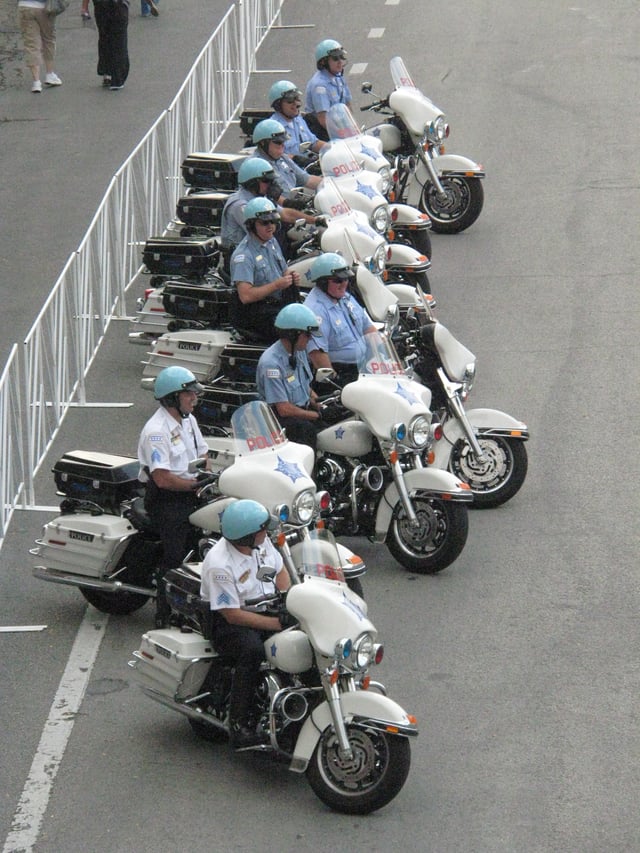
The police motorcade awaits the start of the 2007 Chicago Marathon.
Over the years, the Chicago Police Department has been the subject of a number of scandals, police misconduct and other controversies:
Summerdale scandals
The Chicago Police Department did not face large-scale reorganization efforts until 1960 under Mayor Richard J. Daley. That year, eight officers from the Summerdale police district on Chicago's North Side were accused of operating a large-scale burglary ring. The Summerdale case dominated the local press, and became the biggest police-related scandal in the city's history at the time. Mayor Daley appointed a committee to make recommendations for improvements to the police department. The action resulted in the creation of a five-member board charged with nominating a superintendent to be the chief authority over police officers, enacting rules and regulations governing the police system, submitting budget requests to the city council, and overseeing disciplinary cases involving officers.[10] Criminologist O.W. Wilson was brought on as Superintendent of Police, and served until 1967 when he retired.[11]
1968 Democratic National Convention

Film shot by DASPO of the protests and Chicago police and military response to the protests
Both Daley and the Chicago Police Department faced a great deal of criticism for the department's actions during the 1968 Democratic National Convention, which was held in Chicago from August 26 to 29, 1968.
The convention was site of a series of protests, mainly over the war in Vietnam. Despite the poor behavior of some protesters, there was widespread criticism that the Chicago Police and National Guard used excessive force. Time published an article stating;
With billy clubs, tear gas and Mace, the blue-shirted, blue-helmeted cops violated the civil rights of countless innocent citizens and contravened every accepted code of professional police discipline. No one could accuse the Chicago cops of discrimination. They savagely attacked hippies, yippies, New Leftists, revolutionaries, dissident Democrats, newsmen, photographers, passers-by, clergymen and at least one handicapped. Winston Churchill's journalist grandson got roughed up. Even Dan Rather (the future CBS News anchor) who was on the floor doing a report during the convention got roughed up by the Chicago Police Department. Playboy's Hugh Hefner took a whack on the backside. The police even victimized a member of the British Parliament, Mrs. Anne Kerr, a vacationing Laborite who was maced outside the Conrad Hilton and hustled off to the lockup.[34]
Subsequently, the Walker Report to the U.S. National Commission on the Causes and Prevention of Violence called the police response a "police riot," assigning blame for the mayhem in the streets to the Chicago Police.
The Black Panther raid
On December 4, 1969, Black Panther Party leaders Fred Hampton and Mark Clark were shot and killed by officers working for the Cook County state's attorney. Though the police claimed they had been attacked by heavily armed Panthers, subsequent investigation showed that most bullets fired came from police weapons. Relatives of the two dead men eventually won a multimillion-dollar judgment against the city. For many African Americans, the incident symbolized prejudice and lack of restraint among the largely white police. The incident led to growing black voter disaffection with the Democratic machine.[26]
Ryan Harris murder
On July 28, 1998, an 11-year-old girl, Ryan Harris, was found raped and murdered in a vacant lot in the city's Englewood neighborhood. The homicide caught the nation's attention when, 12 days after Ryan's body was found, authorities, with the blessing of police command, charged a 7-year-old boy and 8-year-old boy with the murder, making them the youngest murder suspects in the nation at the time.[35] Semen found at the scene and subsequent DNA tests totally cleared the boys of the crime and pointed to convicted sex offender Floyd Durr. The boys each filed lawsuits against the city, which were eventually settled for millions of dollars. Durr pleaded guilty to the rape of Harris, but never admitted to her murder.[36]
Russ/Haggerty shootings
In the summer of 1999, two unarmed black motorists, Robert Russ and LaTanya Haggerty, were both fatally shot in separate incidents involving the Chicago Police. In the first incident, Russ, an honor student and star football player for Northwestern University, was shot inside of his car. This followed a high-speed chase and what the police claim was a struggle with the officer who shot him. In the second, Haggarty, a computer analyst, was shot by a female officer. Charges of racism against the CPD persisted, despite the fact that officers in both incidents were also black. Both shootings resulted in lawsuits and Haggerty's family reached an $18 million settlement with the city.[37]
In Malcolm Gladwell's book on the cognitive function of snap judgments, Blink,[38] well-known criminologist and police administrator James Fyfe said that Chicago police instructions in cases such as Russ's were "very detailed."[39] He said that the record shows that the officers involved all broke procedure and let the situation become unnecessarily deadly for the suspect. For instance, after claiming to see Russ drive erratically, the officers engaged in a driving pursuit. The pursuit, labeled "high-speed," did not exceed 70 miles per hour, but Fyfe contends that the adrenaline rush of the chase, coupled with the officers' reliance in their numbers, led to their ignoring impulses to maintain rational thinking in a potentially non-deadly situation. They speeded up a process that both allowed and required taking things more slowly and methodically. Russ's car spun out on the Ryan Expressway, at which point several officers quickly approached his vehicle. According to Gladwell, the false safety of numbers gave the three officers "the bravado to rush the car." Fyfe adds, "The lawyers [for the police] were saying that this was a fast-breaking situation. But it was only fast-breaking because the cops let it become one. He was stopped. He wasn't going anywhere."
Fyfe describes appropriate police procedure and contrasts the events that contributed to Russ's death thus,
[According to police instructions] You are not supposed to approach the car. You are supposed to ask the driver to get out. Well, two of the cops ran up ahead and opened the passenger side door. The other [officer] was on the other side, yelling at Russ to open the door. But Russ just sat there. I don't know what was going through his head. But he didn't respond. So this cop smashes the left rear window of his car and fires a single shot, and it hits Russ in the hand and chest. The cop says that he said, 'Show me your hands, show me your hands,' and he's claiming now that Russ was trying to grab his gun. I don't know if that was the case. I have to accept the cop's claim. But it's beside the point. It's still an unjustified shooting because he shouldn't have been anywhere near the car, and he shouldn't have broken the window.[40]
Gladwell also notes that the Russ and Haggerty killings occurred on the same night.[39]
Joseph Miedzianowski
In April 2001, Joseph Miedzianowski was convicted of racketeering and drug conspiracy during much of his 22-year career with the department. In January 2003 he was sentenced to life without the possibility of parole. His partner John Galligan and 24 other drug dealers were also arrested as part of the same investigation.[41]
William Hanhardt
In October 2001, Deputy Superintendent William Hanhardt pleaded guilty to running a nationwide jewel-theft ring that over twenty years may have stolen five million dollars' worth of diamonds and other gems. He had served with the department for 33 years and was sentenced to twelve years in federal custody.[42]
Eddie C. Hicks
In December 2001, Sergeant Eddie C. Hicks was indicted for operating a gang with other CPD officers. The group would raid drug houses, taking the contraband for resale. Hicks skipped a court appearance on June 9, 2003,[43] and was placed on the FBI's most-wanted list.[44] Hicks was arrested in Detroit on September 12, 2017, nearly 15 years after he fled on the eve of trial on federal drug conspiracy charges. Hicks, 68, has been the subject of an international manhunt since 2003, according to the FBI. He appeared in federal court in Detroit on Tuesday and was ordered held until he can be brought to Chicago to face the charges.[45]
Jon Burge torture allegations
Since the early 1980s, official investigations have responded to numerous allegations against former Commander Jon Burge, who has been accused of abusing more than two-hundred mostly African-American men from 1972 to 1991 in order to coerce confessions to crimes.[46] Alleged victims claimed that Burge and his crew of detectives had them beaten, suffocated, burned, and treated with electric shock. In 1993, Burge was fired from the department, and is currently collecting his police pension. In summer 2006, special prosecutors completing a four-year investigation concluded that they had enough evidence to prove crimes against Burge and others, but "regrettably" could not bring charges because the statute of limitations had passed.[46] In January 2008, the City Council approved a $19.8 million settlement with four men who claimed abuse by Burge and his men.[47]
In October 2008, Patrick J. Fitzgerald, United States Attorney for the Northern District of Illinois, had Burge arrested on charges of obstruction of justice and perjury in relation to a civil suit regarding the torture allegations against him. Burge was eventually convicted on all counts on June 28, 2010 and was sentenced to four and one half years in federal prison on January 21, 2011.
Nurse arrests
On November 19, 2002, Rachelle Jackson, a registered nurse, was on her way to work when she witnessed a vehicle accident involving a patrol car, in which Officer Kelly Brogan was dazed and her partner was unconscious. Fearing an explosion, Jackson removed both officers from the vehicle, and voluntarily went to the police station under the assumption of giving a statement after being informed that Brogan's service weapon was stolen. Instead she was interrogated for two days with little food or sleep and no access to a bathroom.[50] She was coerced into signing a statement that she had battered Brogan and taken her gun. She was jailed for 10 months before the charges were dismissed. Jackson was awarded $7.9 million by a jury in her lawsuit against Brogan and the city. In 2009, the amount was reduced to $1.9 million.[51] More than half the original verdict was awarded for "intentional inflection of emotional distress."[52]
Bar attack
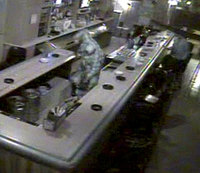
Bartender being punched and kicked by off duty Chicago Police officer Anthony Abbate.
In 2007, security camera footage surfaced of an intoxicated off-duty police officer, Anthony Abbate, punching and kicking a female bartender, Karolina Obrycka. This occurred at Jesse's Shortstop Inn on February 19, 2007, after Obrycka refused to serve him any more alcohol. Abbate was later arrested, charged with felony battery, and stripped of police powers after TV news stations aired the footage. The Chicago Police soon terminated Abbate from the force, but questions remained over the city's handling of the case.[53]
Abbate was allowed to enter his courtroom hearing through a side door, in order to shield himself from the press. This generated controversy and allegations surfaced that the police ticketed the vehicles of news organizations and threatened reporters with arrest. Superintendent Cline announced that he would demote the Captain who gave the orders, and launched investigations into the actions of the other officers involved.[54]
Referring to Abbate, Superintendent Phil Cline stated, "He's tarnished our image worse than anybody else in the history of the department."[57] The video of the attack has been viewed worldwide on 24-hour news channels and has garnered more than 100,000 views on YouTube. In the wake of this scandal and a similar scandal related to another videotaped police beating at a bar, Cline announced his retirement on April 2, 2007. While both men have denied it, some believe that Cline retired under pressure from Mayor Richard M. Daley.[58] Daley has since announced a plan to create an independent police review authority to replace the current Office of Professional Standards (OPS), which is under the jurisdiction of the police department.[59]
On April 30, 2007, attorneys representing Obrycka filed a lawsuit in the United States District Court for the Northern District of Illinois against the city of Chicago and Abbate and several other individuals.[60] On November 13, 2012, a federal jury found that a "widespread code of silence" within the Chicago Police Department had allowed Abbate to feel that he could attack Obrycka without fear of reprisal. They also found that Abbate participated in a conspiracy to cover up the attack. The jury awarded Obrycka $850,000 in damages.[61]
Abbate was convicted of aggravated battery, a felony, on June 2, 2009. Cook County Circuit Judge John J. Fleming rejected Abbate's claims that he had acted in self-defense. However, since Obrycka testified that Abbate had not identified himself as an officer during the attack Abbate was acquitted of official misconduct charges. Abbate faced up to five years in prison for the attack. On June 23, 2009, Abbate was sentenced to two years probation, including a curfew between 8 pm and 6 am, mandatory attendance at anger management classes, and 130 hours of community service.[62]
On December 15, 2009, Abbate was officially fired from the CPD after a mandatory review by the Chicago Civilian Police Board.[63] The firing was a formality, as the CPD does not allow convicted felons to serve on the force.
Jerome Finnigan
Chicago Police Officers Jerome Finnigan, Keith Herrera, Carl Suchocki, and Thomas Sherry were indicted in September 2007 for robbery, kidnapping, home invasion, and other charges. They were alleged to have robbed drug dealers and ordinary citizens of money, drugs, and guns. The officers were all part of Special Operations Sections (SOS). The officers had allegedly victimized citizens for years; however, allegations of their misconduct was not investigated until 2004. According to the State's Attorney, the officers repeatedly missed court dates and allowed alleged drug dealers to go free. Several lawsuits alleging misconduct on behalf of Finnigan and his team have been filed in federal court. Since the original indictments, Jerome Finnigan has also been charged with attempting to have several fellow officers killed. Since the scandal involving Finnigan, SOS has been disbanded.
On February 11, 2009, charges against Chicago Police Department officers Tom Sherry and Carl Suchocki were dropped. A Cook County judge dismissed all criminal charges accusing them of robbery and home invasion after some evidence was proven to be false, and witnesses in the case against Sherry and Suchocki were unable to place the officers at the scene of the crime. Charges against Herrera and Finnigan, however, are still pending. As of September 25, 2009, seven former SOS officers have pleaded guilty to charges relating to the scandal. The investigation is ongoing as police officers continue to come forward and cooperate with the state and federal investigation.[64][65][66][67][68][69]
Shooting of Flint Farmer
On June 7, 2011, Flint Farmer was fatally shot three times in the back by Chicago police officer Gildardo Sierra. Sierra and a partner had responded to a domestic disturbance call allegedly involving Farmer. When confronted by the police, Farmer fled. Sierra shot at Farmer multiple times, hitting him in the leg and abdomen. Publicly available police video shows Sierra circle the prone Farmer as three bright flashes emit from approximately waist level.[70] The coroner who performed the autopsy on Farmer reported that Farmer could have survived the shots to the leg and abdomen, but any of the three shots through the back would have been fatal.[70] Officer Sierra had been involved in two other shootings in 2011. Although the Chicago police department ruled the shooting justified, by October 23, 2011 Sierra had been stripped of his police powers and the FBI had opened an investigation into the incident. Eventually, no charges were brought against the officers. The city settled the civil case with Farmer's family for $4.1 million but did not admit fault.[71][72]
Richard Zuley
After his retirement multiple inquiries into overturned convictions that had relied on confessions he coerced triggered the Conviction Integrity Unit of the Cook County State's Attorney's Office to plan to subpoena Zuley's entire complaint history.[73]
Zuley faces multiple lawsuits from individuals who claim he framed them, or beat confessions from them.[73] Lathierial Boyd was exonerated and freed in 2013 after serving 23 years in prison, based on evidence from Zuley and suppression of exculpatory evidence. He filed a federal civil rights lawsuit, as well as suing the city, saying that Zuley framed him for a murder and attempted murder outside a nightclub in 1990. Anthony Garrett, who received a 100-year sentence for killing a seven-year-old boy, alleged Zuley beat his confession out of him.
On February 18, 2015, Spencer Ackerman, reporting in The Guardian, covered Zuley's alleged involvement in the torture and forced confessions of several homicide cases in Chicago. He said several inmates claimed abuse by Zuley.
In addition, he revealed additional details of Zuley's participation as a US Navy Reserve lieutenant from late 2002 to 2004 in the interrogation and torture of Guantanamo captive Mohamedou Ould Slahi. Slahi was among several men classified by the US as high-value detainees, for whom the Secretary of Defense authorized extended interrogation techniques, since characterized as torture.[74]
Jason Meisner, writing in the Chicago Tribune, reported that The Guardian characterized Zuley's use of torture as "brutal and ineffective".[73] Memos Zuley wrote, quoted in the Senate Intelligence Committee's report on the CIA's use of torture, described him using "stress positions"—the shackling of interrogation subjects in painful postures for extended periods of time. Zuley currently faces lawsuits in Chicago for using these techniques against American civilians.
Homan Square
The Guardian reported in February 2015 that the Chicago Police Department "operates an off-the-books interrogation compound, rendering Americans unable to be found by family or attorneys while locked inside what lawyers say is the domestic equivalent of a CIA black site." The Guardian added that the facility, the Homan Square Police Warehouse at 1011 S. Homan Ave in Chicago (41°52′06″N 87°42′36″W [93] ), "has long been the scene of secretive work by special police units." The Guardian said that interviews with local attorneys and one protester "describe operations that deny access to basic constitutional rights ... The secretive warehouse ... trains its focus on Americans, most often poor, black and brown ... Witnesses, suspects or other Chicagoans who end up inside do not appear to have a public, searchable record entered into a database indicating where they are, as happens when someone is booked at a precinct. Lawyers and relatives insist there is no way of finding their whereabouts. Those lawyers who have attempted to gain access to Homan Square are most often turned away, even as their clients remain in custody inside."[75][76][77][78][79][80][81][82][83]
After the Guardian published the story, the Chicago Police provided a statement saying, without specifics, that there is nothing improper taking place at what it called the "sensitive" location, home to undercover units. The statement said "CPD [Chicago Police Department] abides by all laws, rules and guidelines pertaining to any interviews of suspects or witnesses, at Homan Square or any other CPD facility. If lawyers have a client detained at Homan Square, just like any other facility, they are allowed to speak to and visit them." The Guardian said several attorneys and one Homan Square arrestee have denied this. The CPD statement continued by saying "There are always records of anyone who is arrested by CPD, and this is not any different at Homan Square." The Guardian said the Chicago Police statement did not address how long into an arrest or detention those records are generated or their availability to the public, and that a department spokesperson did not respond to a detailed request for clarification.[75]
Laquan McDonald

Voice of America news report of the third day of protests in Chicago after the release of a video of the shooting of Laquan McDonald
On October 20, 2014, 17-year old Laquan McDonald was fatally shot by Officer Jason Van Dyke.[84] The killing sparked protests and calls for the mayor to resign.[84] A video released revealed McDonald walking down a street, carrying a knife.[84] McDonald was walking parallel to the two police cars when he was shot 16 times.[84] A criminal complaint filed in Cook County Circuit Court revealed that Van Dyke was the only officer to shoot.[84] The complaint also said that McDonald was on PCP at the time of his death.[84] Protestors were frustrated that the video took 13 months to release.[84] A freelance journalist sued to have the footage released as it was a public record.[84] A judge found in the reporter's favor and the video became public in November 2015.[84]
Van Dyke was charged with six counts of first-degree murder and one count of official misconduct.[84] He remained on desk duty after the shooting.[84] Van Dyke had a history of complaints in his career but was cleared in a majority of the cases.[84] He pleaded not guilty on December 29, 2015 to the charges against him.[84] After his arraignment, his attorney, Daniel Herbert, said that he would be looking for evidence to clear his client's name.[84]
2017 Department of Justice report and agreement for enforcement
Following the McDonald shooting, Illinois State Attorney General Lisa Madigan requested that the US Department of Justice conduct a civil rights investigation of the Chicago Police Department. They released their report in January 2017, announcing an agreement with the city to work on improvements under court supervision. They strongly criticized the police for a culture of excessive violence, especially against minority suspects and the community, and said there was insufficient and poor training, and lack of true oversight.[6]
See also
Chicago Police Accountability Task Force
Citizen Law Enforcement Analysis and Reporting
Crime in Chicago
Cook County Sheriff's Office
List of law enforcement agencies in Illinois